Want to find out how you can start a fitness blog for your gym or fitness club business? You’re in the right place! In this how-to guide, we’ll help you create a fitness blog that your members and prospects will want to read.
A fitness blog can help your business build brand authority. Help you attract new prospects and members. Give your website a search engine rankings boost. And even help your members get more from their membership.
Good news! Blogging is a low cost gym marketing option. And it’s pretty simple to get started. We’re here to help.
Read on to learn more about the benefits of blogging for your business. Find out how to start a fitness blog in 9 steps. And get fitness blog examples from other UK gyms.
Let’s get stuck in!
Power up your business & stay in the know
What is a fitness blog?
A fitness blog is a place where you can share health, fitness, and other content with your prospects and members in articles. For most gyms, a blog will be a part of your website and acts as a marketing channel where you can promote your business.
Posts are articles on your blog. These can be published by your business, yourself, your team members, your partners, or a mix of all these. It’s up to you! Posts on your gym blog should aim to educate, entertain, and influence readers.
Different fitness blogs, and even posts within one blog, can have different purposes and audiences. Blogging will help you promote and position your business as a leader in the market.

Is it worth starting a fitness blog?
Short answer – yes! It’s worth starting a fitness blog for your gym or fitness club business. That said, you will see better results from your blog when you post regularly. So, if you want to start a blog, work out if this is achievable.
Starting a blog for your business is an investment. And with the right approach, it’s one that can keep delivering results long into the future.
So, why is it worth starting a fitness blog for your gym business? Let’s take a look:
Builds brand authority
For many clubs, this will be the biggest benefit of blogging. The best fitness blogs answer common questions about health and fitness.
Use your blog to provide valuable info. And you’ll show the knowledge and expertise within your gym business. Research has found that over 70% of consumers prefer to learn about brands through content rather than ads.
So, blogging can help you build brand authority that creates trust. And this makes it easier to attract new members, keep existing ones, and sell new products and services.
Drives relevant traffic to your website
Create blog posts that resonate with your target readers. And cover popular topics searched for online. As a result, you’ll drive relevant traffic to your website. That can help you win more new signups and sales.
Run a gym chain? Offer online fitness services? Then blogging can help you reach your target audience as they are looking for info. How? By publishing blog posts that are optimised for search engines like Google.
Each time you write and publish a blog post, it’s a new page on your website. And that’s another chance to show up on the search engine results page (SERP) and drive traffic to your site. It shows Google and other search engines that your site is active.
Gives you content to repurpose for social
Every time you publish a new blog post, you’re creating content that can be shared on social media. Think Facebook, X and even WhatsApp. And so, this can help you reach new members and take advantage of word of mouth gym marketing too.
It also gives you a regular source of content that you can share across the social media accounts you’ve set up for your fitness business. And in doing so, you’ll drive traffic to your website.
And gives you content for your newsletter
Does your gym business have a fitness newsletter? Just like a blog, a newsletter can help you build brand loyalty, grow your business and increase retention. And starting a fitness blog can make managing your newsletter easier.
Regularly create and publish a variety of blog posts. And you’ll have content that you can include in your email newsletter. Plus, you’ll be able to link out to your blog posts, sending traffic to your website. And keeping your newsletters short and sweet!
Helps convert traffic to leads and sign ups
With traffic coming to your website via your blog, you’ve got the chance to convert that traffic into leads and even new members. How? By adding a call-to-action (CTA) encouraging them to take a next step.
Sometimes it’ll be appropriate to encourage readers to join your fitness club. And at other times, you’ll want to include a lighter CTA. Options include:
- Newsletter sign up
- Download a free piece of content (e.g. a how-to guide, training programme, or workout sheet)
- Free day pass
- Book a tour
Provides health and fitness education
You (and your team) are experts when it comes to health and fitness. And you provide valuable education and guidance to members visiting you in person. A health and fitness blog can help you extend your reach.
Create and publish blog posts that cover popular topics and answer common questions. And you’ll help more members (and prospects) on their fitness journey. You can keep directing members to these posts. Plus, you can even include them in the emails that make up your gym member onboarding process.
Allows you to share news
A gym blog is also a great place to share the latest news about your fitness business. So, you keep members up to speed with what’s going on.
Promote fitness events you’re running. Encourage members to sign up to your gym challenges. Introduce new team members. Showcase new group fitness classes that you’re adding to your timetable. Share member success stories. The list goes on!
Powers long-term results
Your fitness blog posts can deliver results long after you publish them. Especially when they’re optimised for search engine distribution.
Posts can rank for days, weeks, months, and even years to come. And that means you’ll keep getting traffic from posts with high SERP rankings.
So, when you add CTAs to these blog posts you can keep using them to bring in leads, increase sales, and win new members. Write well targeted, evergreen blog posts and you’ll power long-term results.
Creates an opportunity to add a new revenue stream
Often starting a fitness blog for your gym is about better serving prospects and members. Yet, it can also create an opportunity to add a new source of revenue for your gym business.
How? By embracing affiliate marketing. So you can generate an income from your blogs by referring readers to relevant products and services. This can be a way of diversifying income for your business.

How to start a fitness blog in 9 steps
As you can see, there are many benefits of blogging for your gym business. How do you start a fitness blog? Let’s take a look!
Step 1: Decide what you want to achieve
Blogging is an investment, you’ll be spending time and possibly money to write and publish your posts. So, it’s important to know what you’re trying to achieve with your blog.
In other words, you should set a goal or goals for your new fitness blog. Making time for goal setting at this stage will make it easier to work out what to write about and more.
Common goals when starting a fitness blog include:
- Building brand awareness and authority
- Increasing visibility and traffic from search engines like Google
- Attracting website visits from social media
- Winning new members
- Generating new leads
- Growing sales of fitness services like personal training
- Educating members
Step 2: Work out what to write about
With your goals set, it’s time to choose the topics that you’re going to focus on within your blog.
Is your fitness business already established? Then the topics you cover should match up to what your brand is all about. For example, if you run a club specialising in women’s health and fitness then your posts should be relevant for this audience.
Finding a niche to focus on can help you grow your blog faster than posting about health and fitness in general. You’ll become known for that topic and build authority in that area.
Does your gym or fitness club business have a broad target audience? Then a general fitness blog may be the right route to go down.
So, you know what to focus on, consider they type of topics you want to cover. As you start a blog, you’ll want to choose 1-3 types of posts to focus on.
Fitness blog post ideas include:
- Workout & training guides
- Recovery & healthy living tips
- Nutrition tips
- Success stories
- Club news
- Team & member profiles
Step 3: Get the technical set up right
Next up, it’s time to make sure you have the right technical set up for your blog. Often that starts with choosing a blog name. For most gym and fitness clubs simply calling it the ‘Brand name’ blog is most effective. For example, the Anytime Fitness Blog.
You’ll need to choose a platform for your fitness blog. That could be as simple as ticking a box in your website content management system to say you’d like to add a blog section.
If you don’t have a website yet or you can’t easily add a blog, you’ll need to look at choosing a domain, platform, and hosting.
Domains
A domain is a unique, memorable address used to access your website (e.g., ours is xplorgym.co.uk).
Generally for a blog, and especially if you’re targeting SEO distribution, choose a subfolder of your domain rather than a subdomain. For example, xplorgym.co.uk/blog is better than blog.xplorgym.co.uk.
Platforms & hosting
While your domain is the address used to reach your website and blog, hosting is where your content is stored. There are two hosting options available – self-hosting or hosted.
Generally, self-hosting is recommended using a blogging platform, like WordPress. And paying a hosting company, like SiteGround.
WordPress is often recommended as it’s cost effective, easy to use, and has loads of customisation options. It also tends to perform well with search engines.
Self-hosting like this gives you complete ownership over your content. So, you decide how it’s used and distributed.
With a hosted blogging or website, you’ll get access to an all-in-one platform like Wix.
Ease of use is the biggest benefit of an all-in-one hosted platform. But, you’ll generally have fewer options to customise your blog, less control over advertising, and you’ll need to keep to certain rules.
Step 4: Create a blogging strategy and plan
Having the right strategy and a clear plan in place will help you work towards your blog goals with a consistent approach.
Post frequency
Start by thinking about how often you’ll be able to write and publish blogs. Be realistic about this, consistency will help you achieve better results. For many gym and fitness club businesses, once a week is ideal.
But, depending on how you’ll write your posts, time available, and other priorities, aim for an achievable frequency. Think fortnightly or monthly.
Content calendar
Now you know how often you intend to publish posts, it’s time to plan your fitness content. Think strategically to choose topics that are right for your audience. Go for a mix of evergreen and timely topics.
Brainstorm blog topics ideas. Start by thinking about questions that prospects and members commonly ask. And about tips you frequently give. Often these can be split out into many posts.
Tools like Google Trends can provide topic inspiration. It’s a free tool that shows popular searches by time, season, and location. You can review by category or search for specific terms. For example, search ‘squats’ and see top search topics and queries:
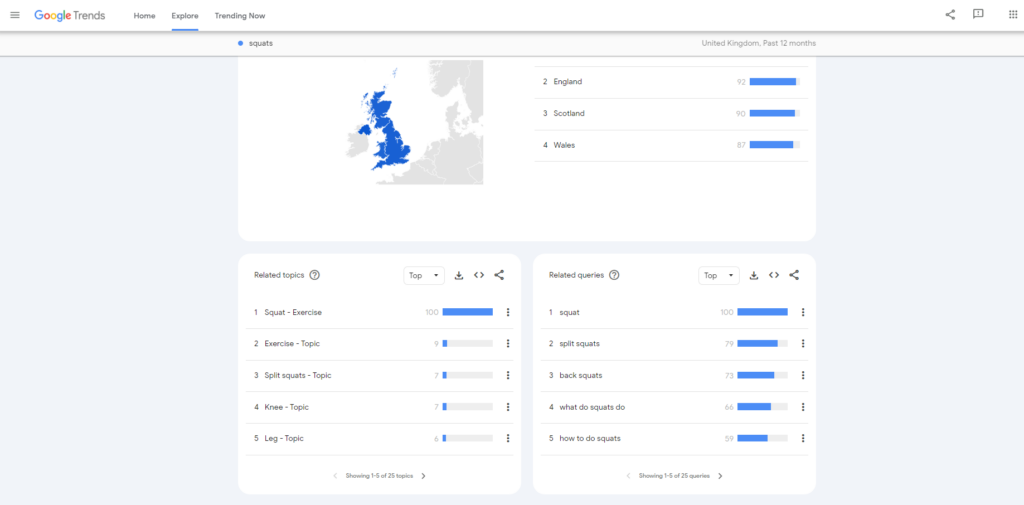
Aim to create a calendar of topics that will last you for 3 to 6 months. And remember, you can always adjust your calendar to cover topics that become relevant.
Writers block is REAL!
TipKeep a list of blog post topic ideas and add to it regularly. That way you’ll always have a list to work from and combat writers block
Step 5: Produce your blog content
Now you have a strategy and plan in place, it’s time to get stuck into producing your blog content.
Decide who will produce your content
Running a gym is time-consuming, so you won’t necessarily have the free time to write all your blog posts. And you don’t have to, as outsourcing can be an effective alternative.
For a modest budget, you can use platforms like Upwork, Freelancer, or Fiverr to find talented freelancers to support your fitness blog.
Copywriting. Gym SEO. Graphic design. And even promotion. It can be a great way to take advantage of blogging without needing to do it all yourself.
Always review outsourced blog content
TipMake sure you or someone in your team with expert knowledge on the topic reviews the accuracy of outsourced blog posts before publishing. This is especially important if you are targeting search engine rankings
Apply your branding
As well as making sure the look and feel of your blog is aligned with your gym branding, make sure you hit the right notes when it comes to tone of voice.
Each post should have the same tone of voice. Matching your branding and speaking to your target audience.
Incorporate imagery and even videos
Blogging isn’t always about your words! Add photos, videos, and graphics to bring the words to life and add interest.
Follow these best practices
As well as adding images and videos, there are other ways you make your posts easier for readers to follow:
- Start with an intro that summarises why the post is a must-read
- Use headings, subheadings, and bullets to make your post easy to scan through and read
- Prove the accuracy of info provided by linking out to credible sources and studies
- Share success stories and anecdotes to help your audience relate to what you’re saying
- Summarise key points made and make it easy for your audience to put what they’ve read into action
Step 6: Optimise for search engines
Is one of your goals to reach your target audience and grow traffic to your website from search engines like Google? Yes? Then you need to look at search engine optimisation (SEO).
What is SEO?
TipSearch engine optimisation (SEO) is the process of making your blog posts visible to search engines like Google or Bing
Arguably this step can come before or after step 5. The best approach will depend on how bigger a focus SEO is for your business. If it’s the primary or even secondary goal of your fitness blog, we recommend starting to look at SEO for gyms ahead of step 5.
Start with keyword research
Your content should be produced with specific keywords in mind. And that means spending a little time on keyword research to identify search terms you’re likely to be able to rank highly for.
There are a selection of free and paid for tools that can help you identify relevant keywords for the topic(s) you want to cover.
Google Keyword Planner is a free option that will recommend keywords and show search volumes. Whereas, paid tools, like Ahrefs, can give you more detailed information. For example, how easy it might be to rank for a term and details of the current website ranking for it.
Identify a primary keyword to rank for and a selection of related secondary keywords that you’d also like to rank for.
Take the right approach
Once you’ve done your keyword research, make sure you take the right approach to your blog. That means following the lead from the sites you’ll be competing against. Here are some pointers for you:
Look at the types of posts that rank highly
For example, most are ‘top X’ listicle articles then follow that style.
Set a target word count
Exactly how long blog posts should be is a highly debated topic in the SEO world. Generally 1,500 to 2,000 words works best as a minimum.
However, the best approach is to look at the articles that currently rank on the first page of results. Aim for a higher word count (or if that’s not achievable without compromising quality, go for the average word count).
Use correctly formatted headings
Headings make it easy for your target audience and search engines to scan through your posts.
Within your blog platform you’ll be able to choose levels of heading. These matter for SEO. Your blog title should always be H1. Create sections using H2 and sub-sections using H3.
Include external and internal links
Linking to external sources of info shows your post is well researched and authoritative.
Internal links help your audience find other relevant content on your site and are helpful for search engines too. They show how your content is organised and connected.
Use keywords strategically throughout your post
Naturally include your primary and secondary keywords in the body and headings of your post.
Also make your primary keyword the URL – e.g. if you are targeting ‘squatting technique’, your URL could be ‘yourgym.co.uk/blog/squatting-technique’.
Check your writing style
When it comes to writing posts that rank in top position, writing style matters. Generally, you’re looking to create short sentences. And use connecting words (like we just did!) to make it easy to follow your article.
Plus, you should avoid complicated language, choosing plain English wherever possible. Using tools like Hemingway Editor can help – aim for grade 6 or lower readability!
Those are some of the ways you can optimise your blog posts for search engines. Follow these and you’ll be well on track to search success!
Step 7: Set up and publish your posts
So, your content is ready and waiting for you to publish it! Congrats! At this stage, we recommend you give it one final proofread for typos and errors.
Proofing your own writing can be tough!
TipSo, find someone else to read it over for you. Not an option? Set your post aside overnight and come back to it refreshed. Plus, tools like Microsoft Word have in-built review tools. Including the option to read your document aloud – making it easier to spot errors
Once you’re happy with your post copy and you have all your images ready, it’s time to set up your post in your website platform. Make sure you pay attention to these key elements:
- Set your headings up correctly (use H1 for your title and H2 etc. for other sub-headings)
- Add alt text to your images (so, they are described and accessible for all visitors)
- Set up external links to open in a new window (and test all links carefully)
- If you are using categories and tags to help readers find relevant content, make sure you choose the most appropriate ones
- Set up the URL
- Add a meta title and meta description
- Select the right author for your post in your website platform
Finally, before you hit publish (or schedule your post for publication at a later time or date) do this… Test to see what your post looks like on different devices (desktop, mobile, tablet).
And that’s it! Your ready to publish your fitness blog post!
Step 8: Promote your fitness blog posts
Wait, there’s more! For each blog post you publish, think about how you’re going to make sure your prospects and members read it.
For most posts, you’ll want to promote and distribute across many channels. Here are some promo ideas for your newly published fitness blog post:
- Share to your social media channels and encourage your community to discuss it
- Promote it via gym email marketing to the target audience it would most resonate with. (Tip: use the gym marketing software features within your gym management system to segment your audience and send these emails)
- Add it to your fitness newsletter
- Ask any affiliates or partners to share it with their customers
Plus, if you’re targeting search engine distribution for your new blog post, that’s another form of promotion.
Using a tool like Google Analytics will help you to track the success of your fitness blog. Traffic is just one indicator of success. For example, looking at average engagement time shows whether your posts are actually being read.
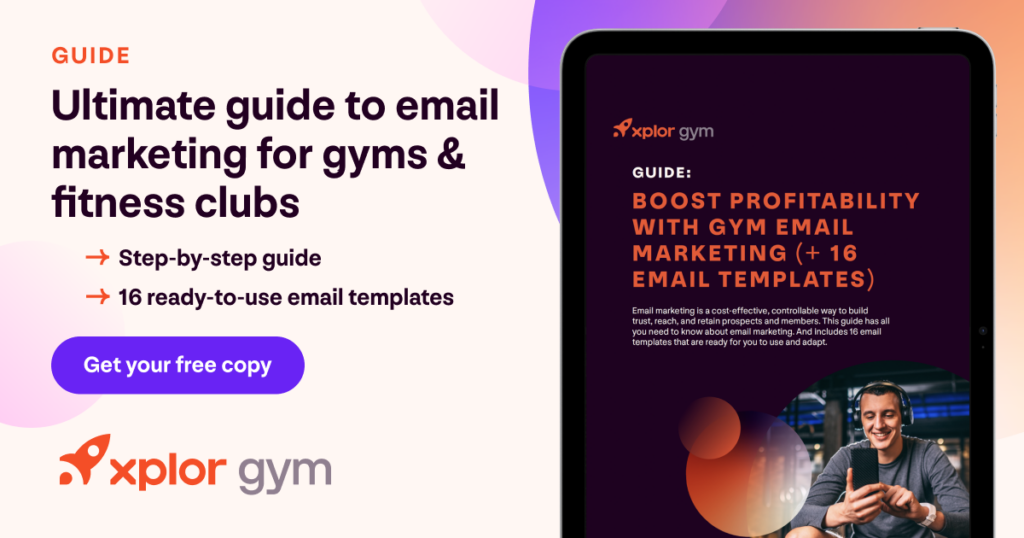
Step 9: Monetise your blog
Once you’ve started your fitness blog, you may want to consider using it to create a new revenue stream for your gym business.
Keep in mind that you’re likely to see the best performance from your blog when you focus on delivering valuable info to your prospects and members. That means looking beyond promoting memberships, services, and products that you already offer. For gym and fitness clubs, monetising blogs is usually a ‘nice-to’ goal.
Here are some ideas for monetising your blog:
- Affiliate marketing – partner with fitness-related companies to promote their products or services. Track clicks and sales via affiliate links. You’ll usually earn a commission for each successful sale
- Ads – sell space in and around your blog to advertisers who’d like to reach your audience
- Sponsored content – collaborate with other fitness brands and businesses to create sponsored content for your blog. That might mean posting reviews or letting them put up a guest post

Fitness blogs examples
Now you’ve seen how to start a fitness blog! Let’s look at how other gym and fitness clubs across the UK and Ireland are blogging. So, you can see what’s working and decide how to set your business apart.
The Engine House Gym
Located near Wantage, The Engine House Gym offers members small group training that’s personalised to individual goals. The gym has a big emphasis on community, motivation, and expert support.
And this is evident in the gym’s blog too! To keep it simple, there are 4 categories of post to choose from. This is a really smart way to avoid reader overwhelm. Plus, it makes it easier to stick to planned topic categories when writing posts.
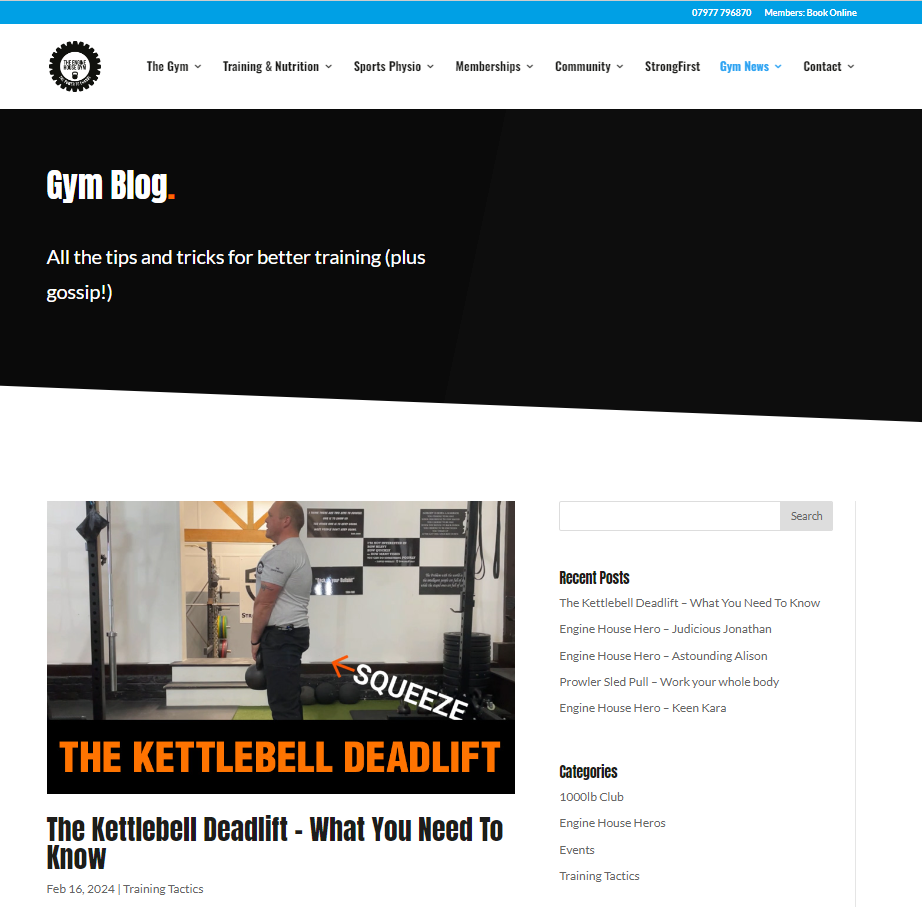
A touch of humour, mixed with outstanding fitness expertise, is evident throughout the posts. Each post has an image or GIF. And these perfectly set up the content of the post, grab attention fast, and never fail to make the reader smile! This one for example.
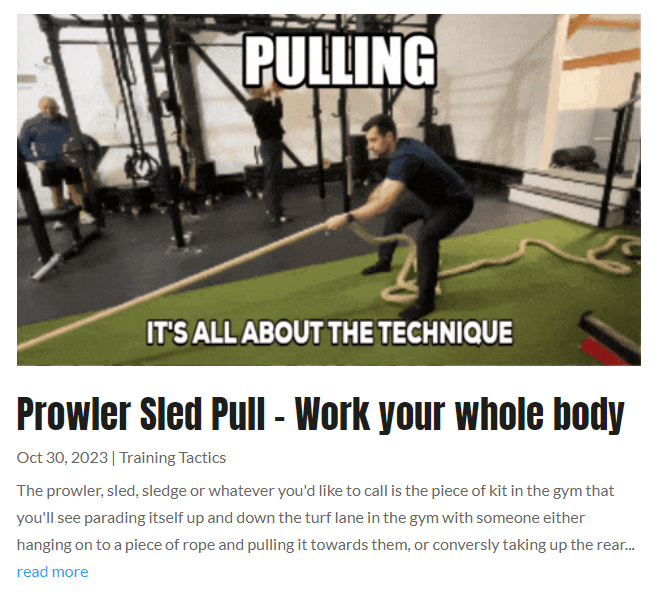
Blog posts that outline workouts give really clear instructions and explain the benefits too. A great way to educate members!
We also love the ‘Engine House Hero’ success stories that regularly celebrate the gym’s members. Carefully branded, these use a playful tone of voice and have a distinct style.

PureGym
Leading no contract, affordable gym operator PureGym runs hundreds of gyms across the UK. As you might expect from such a big player, the PureGym blog is extensive!
It covers many different topics and has numerous categories. There’s really something for everyone! As you arrive on the blog, you’re greeted with a spotlighted post, 4 popular posts, and then the latest posts.

Blog posts make use of personal trainer expertise. For example, this one ‘Gym machine workout routine for beginners’ features insights from PT Suzy Quinn. A clearly structured article, it makes it easy for new gymgoers to get started with machines and even gives two workouts to follow.
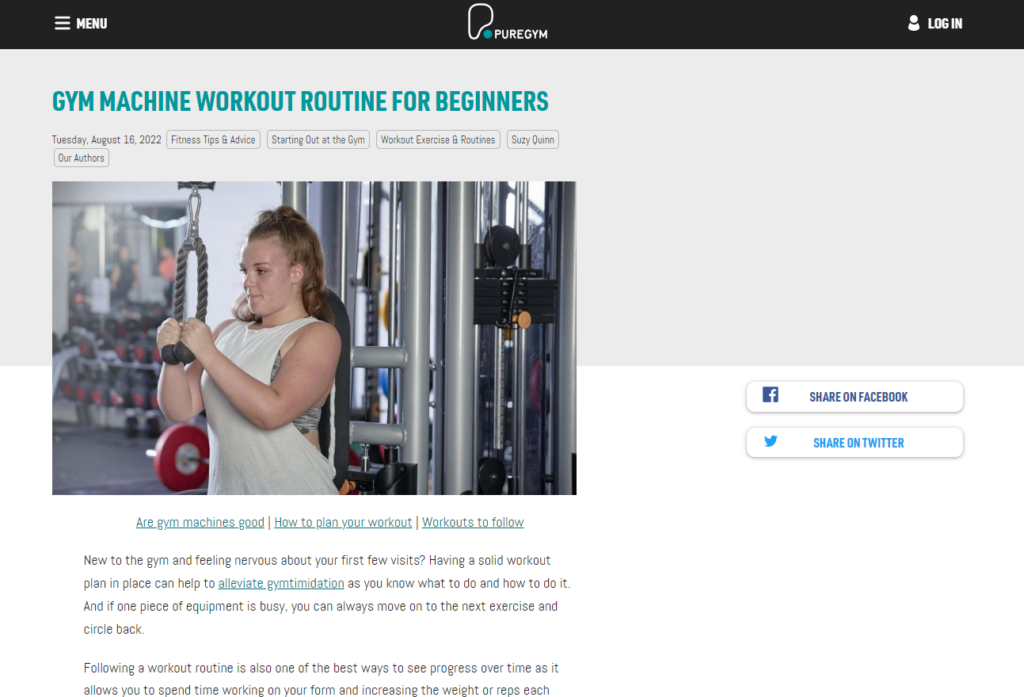
PureGym also builds trust and authority by making it clear who has contributed to posts. This is helpful both for the reader and for search engines. The gym chain even features articles from high-profile athletes like this one from Olympian Sir Chris Hoy.

TFD Health & Fitness
TFD Health & Fitness is a spacious independent gym located in Wantage. The club does a fantastic job blogging to provide prospects and members with a wealth of posts to inform, inspire, and entertain.

Using simple titles, it’s clear to understand what each blog will be about. Categories are also used to make navigation easy.
For example, this ‘Pull up’ article is written by a personal trainer, and includes clear photos to help the reader understand how to perform the move. Plus, it even includes helpful progressions.
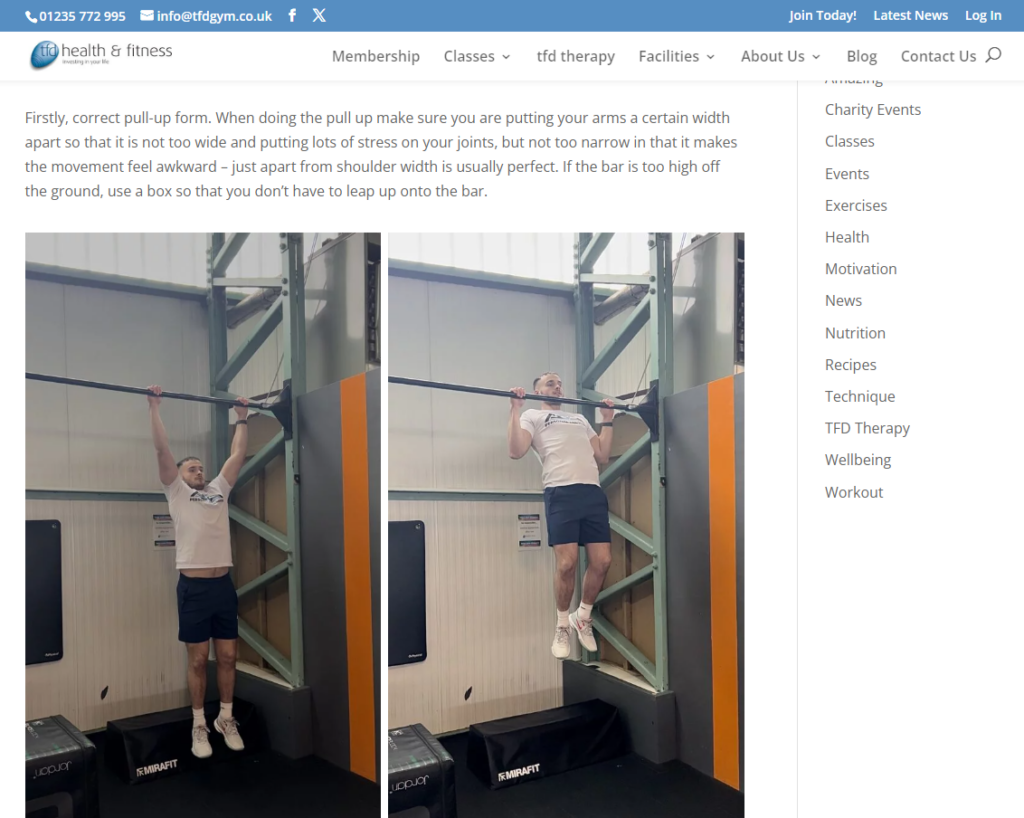
Anytime Fitness UK
Anytime Fitness is a leading gym franchise with 185+ locations across the UK and Ireland (as well as 5,000+ worldwide). The Anytime Fitness blog provides gymgoers with a regular source of inspiration and advice.

The operator publishes posts every few days. And these fit into 6 clear categories that are shown in a tab style format for easy navigation. Categories include Fitness, Nutrition, Weight Loss, Wellbeing, Training Plans, and Industry News.
Anytime Fitness UK also publishes fitness blog posts from it’s partners. Like this one from LyfeLinez. This approach helps the operator to build authority with posts from expert partners. And it’s a great way of making sure content is readily available to publish.
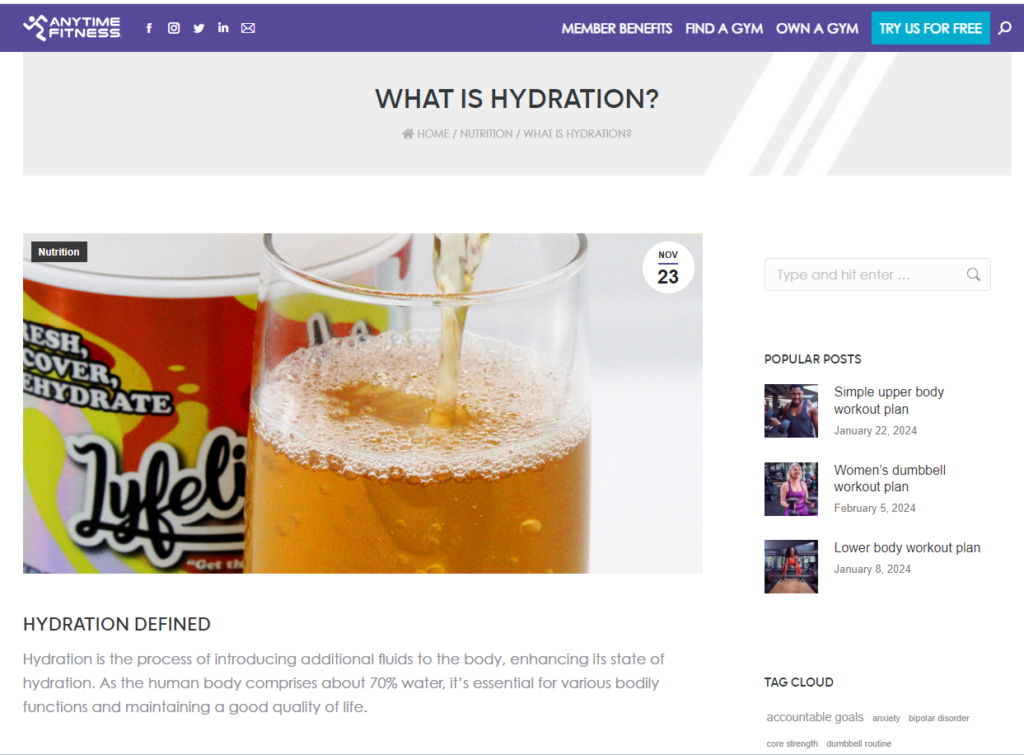
Plus, to generate leads from the blog and increase traffic, Anytime Fitness uses a pop up box as readers go to exit. This calls the reader to sign up to get an email when new blogs are published.
The wrap up…
So, there you have it! Follow the 9 steps on how to start a fitness blog from this article and you’ll be well on your way to realising the perks of blogging for your gym business.
Starting a fitness blog and regularly publishing posts can help you to:
- Build brand authority and awareness
- Drive relevant traffic to your website
- Get content for your social channels, newsletters, and emails
- Generate more leads and membership sign ups
- Educate prospects and members
- Keep members updated with what’s happening at your club(s)
- Achieve long-term results at a relatively low cost
- Add new revenue streams
Happy blogging!
See how software can help make running a gym less admin and more awesome! Request a demo.

by Joanna Ashton Content Marketing Manager, Xplor Gym
-
First published: 04 March 2024
Written by: Joanna Ashton
